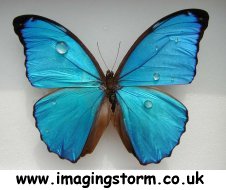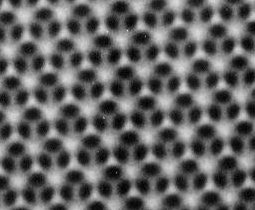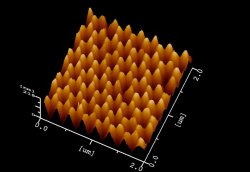 The tropical butterfly Morpho sulkowskyi flashes bright blue as its iridescent wings flutter by. Not only is it astonishingly beautiful, but Japanese chemists believe the secret of what gives these wings their brilliance could lead to a new approach to stay-clean coatings for cars and other surfaces.
The tropical butterfly Morpho sulkowskyi flashes bright blue as its iridescent wings flutter by. Not only is it astonishingly beautiful, but Japanese chemists believe the secret of what gives these wings their brilliance could lead to a new approach to stay-clean coatings for cars and other surfaces.
Osamu Sato of the Kanagawa Academy of Science and Technology and colleagues have discovered the secret of why the butterfly’s shiny wings never seem to get dirty and intend to put their discovery to good use.
They already knew that butterfly wings have a special surface structure. This consists of an array of highly ordered microscopic scales, which produce colour by scattering and refracting light from the scales. This “structural colouring” is unlike the colourful pigments used elsewhere in the natural world which rely on reflecting light at different wavelengths. Structural colour, however, unlike a baboon’s rear, relies on keeping pristine, otherwise the butterfly would revert to a dull grey.
 Sato and his team discovered that there are countless air-filled cavities within the scaly surface of the wing. These, he explains, carry out cleansing duties across the wing’s surface. Any minute droplets of water on the surface ride on a cushion of air and as they roll off they drag with them any clinging dirt particles. This helps maintains the scales’ smooth lustre.
Sato and his team discovered that there are countless air-filled cavities within the scaly surface of the wing. These, he explains, carry out cleansing duties across the wing’s surface. Any minute droplets of water on the surface ride on a cushion of air and as they roll off they drag with them any clinging dirt particles. This helps maintains the scales’ smooth lustre.
Now, the team have copied the butterfly effect. First, they produced a liquid suspension containing finely divided polystyrene beads just a few micrometres across. They then added powdered silicate whose particles are a few tenths the diameter of the beads. A blast of ultrasound makes the particles disperse evenly throughout the liquid. The researchers then dipped a glass slide into this mixture and slowly withdrew it.
As the plastic beads stick to the slide, they pack together like so many apples on a tray into an arrangement known as hexagonal close packing. The beads act as a template for the silicate particles, which fill the gaps between the beads. “During the lifting process, the polystyrene beads self-assemble into a highly ordered structure,” explains Sato. It is the patterned silicate layer in which the researchers are interested though so they next burn off the polystyrene beads at 450 Celsius. This leaves behind a honeycomb of tiny hollow cells formed from the compacted silicate particles.
Size is important when it comes to hollow air pockets. To mimic the colourful effects of the butterfly wing, the holes have to have a diameter close to the wavelength of visible light so they can scatter incoming light waves, explains Sato. By changing the size of the templating beads, the researchers, can fine tune the diameter. In this way, they have made brilliant blue, green and red layers and could produce all the colours in between.
 Their preliminary tests show that these silicate layers, are water repellent because of their air holes. Thus, like the butterfly’s wing any droplets of water are dispersed readily and dirt particles carried away with them. “The sample is not yet very tough, it will peel off if it is scratched,” confesses Sato, “but we are collaborating with Japanese companies to solve this problem.”
Their preliminary tests show that these silicate layers, are water repellent because of their air holes. Thus, like the butterfly’s wing any droplets of water are dispersed readily and dirt particles carried away with them. “The sample is not yet very tough, it will peel off if it is scratched,” confesses Sato, “but we are collaborating with Japanese companies to solve this problem.”
The researchers say their new materials might first find use in quantum dot devices, as optical materials for telecommunications, and as scaffolds for tissue engineering. More immediately commercial applications may be possible such as the self-cleaning car. Whatever colour it is to be, such a vehicle with its butterfly-wing coating is sure to cause a flap.
 The tropical butterfly Morpho sulkowskyi flashes bright blue as its iridescent wings flutter by. Not only is it astonishingly beautiful, but Japanese chemists believe the secret of what gives these wings their brilliance could lead to a new approach to stay-clean coatings for cars and other surfaces.
The tropical butterfly Morpho sulkowskyi flashes bright blue as its iridescent wings flutter by. Not only is it astonishingly beautiful, but Japanese chemists believe the secret of what gives these wings their brilliance could lead to a new approach to stay-clean coatings for cars and other surfaces. Sato and his team discovered that there are countless air-filled cavities within the scaly surface of the wing. These, he explains, carry out cleansing duties across the wing’s surface. Any minute droplets of water on the surface ride on a cushion of air and as they roll off they drag with them any clinging dirt particles. This helps maintains the scales’ smooth lustre.
Sato and his team discovered that there are countless air-filled cavities within the scaly surface of the wing. These, he explains, carry out cleansing duties across the wing’s surface. Any minute droplets of water on the surface ride on a cushion of air and as they roll off they drag with them any clinging dirt particles. This helps maintains the scales’ smooth lustre. Their preliminary tests show that these silicate layers, are water repellent because of their air holes. Thus, like the butterfly’s wing any droplets of water are dispersed readily and dirt particles carried away with them. “The sample is not yet very tough, it will peel off if it is scratched,” confesses Sato, “but we are collaborating with Japanese companies to solve this problem.”
Their preliminary tests show that these silicate layers, are water repellent because of their air holes. Thus, like the butterfly’s wing any droplets of water are dispersed readily and dirt particles carried away with them. “The sample is not yet very tough, it will peel off if it is scratched,” confesses Sato, “but we are collaborating with Japanese companies to solve this problem.”